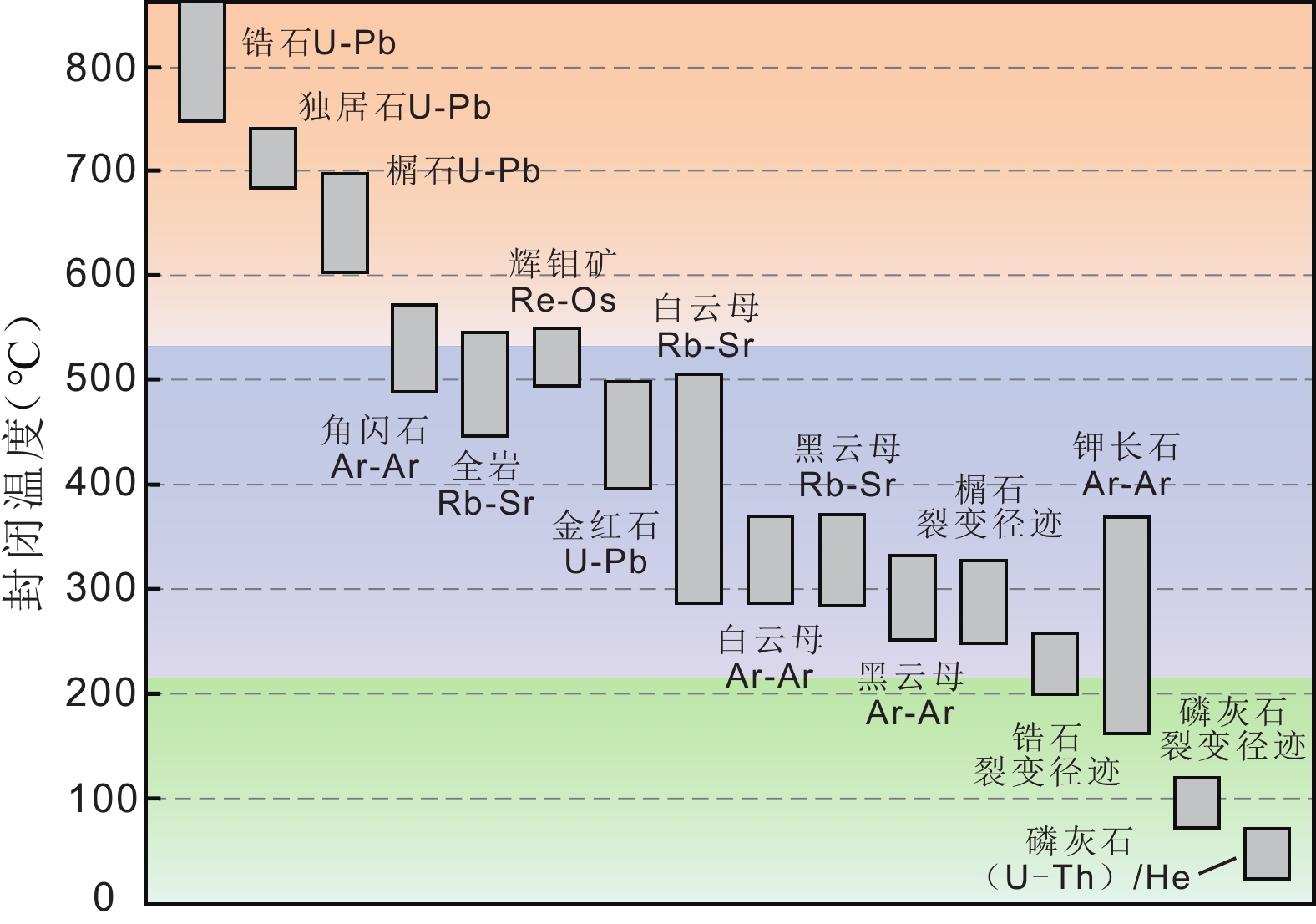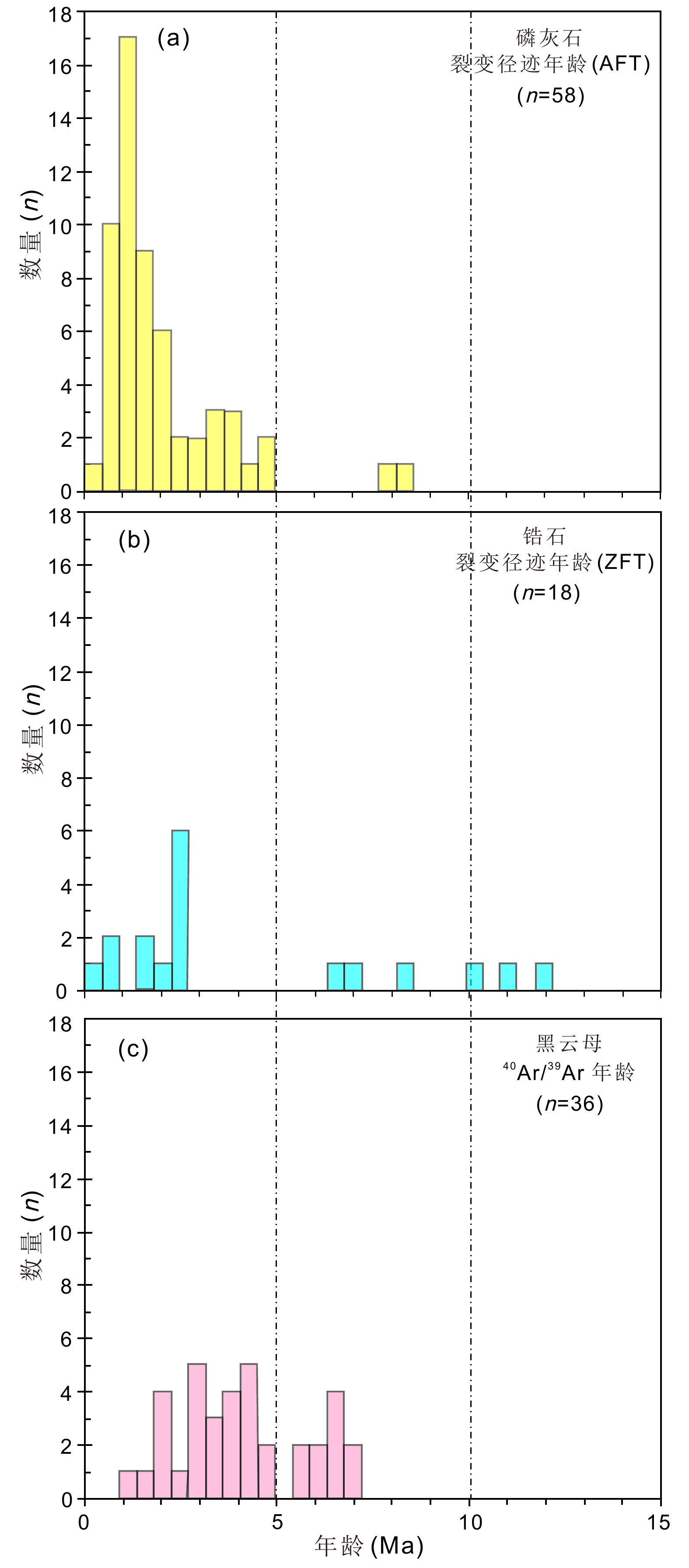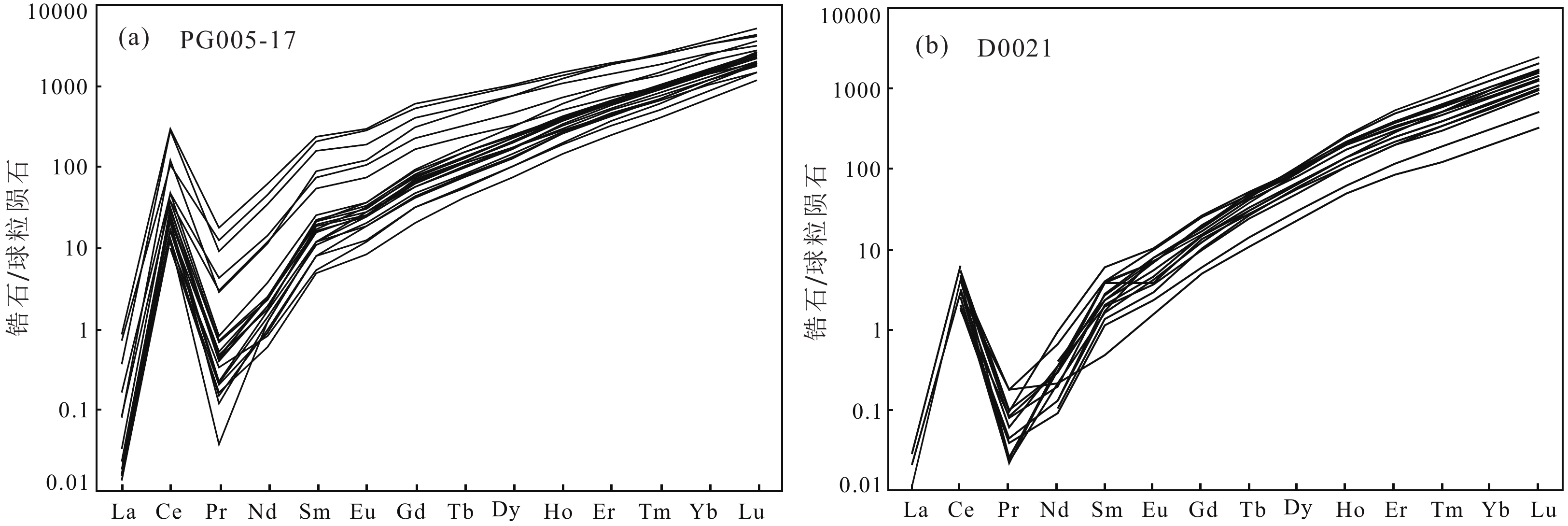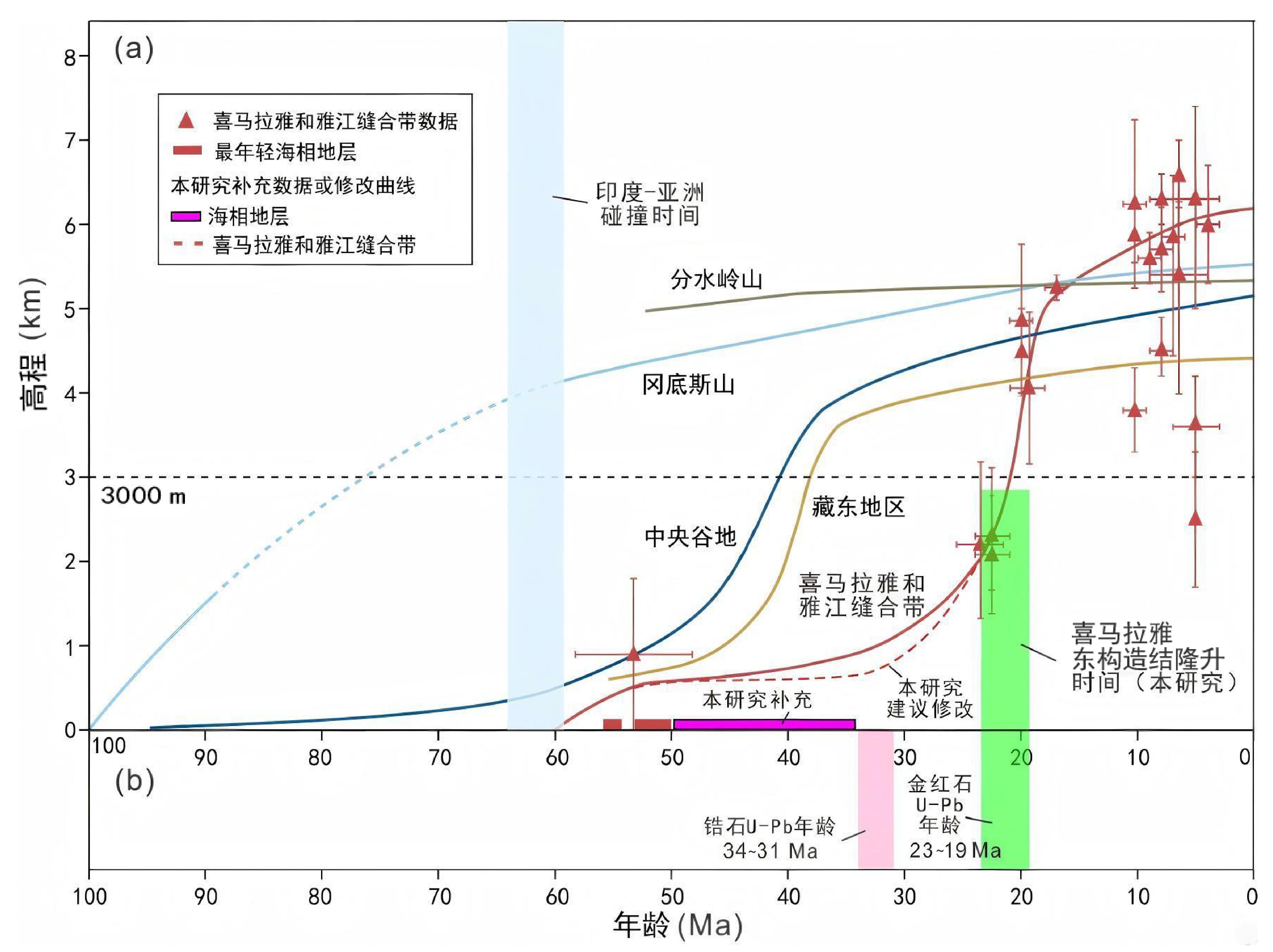Early Miocene uplift of the eastern Himalayan syntaxis: Constraints from U-Pb ages of zircon and rutile
-
摘要:
对喜马拉雅东构造结地区岩石开展锆石和金红石U-Pb年代学研究,以揭示喜马拉雅东构造结早期隆升历史。两件角闪石岩的锆石U-Pb年龄分别为(34.0±0.2) Ma和(31.4±0.4) Ma,相同两件样品的金红石U-Pb年龄分别为(23.8±0.9) Ma和(21.8±0.5) Ma。夕卡岩化石榴石大理岩中的金红石包裹体(寄主矿物为石榴子石)U-Pb年龄为(19.5±0.7) Ma。角闪石岩中的锆石和金红石均为岩浆成因,而金红石包裹体为变质成因。研究认为锆石年龄代表岩浆结晶或岩体侵位时间,而岩浆成因和变质成因金红石的年龄代表结晶后的隆升冷却时间。综合分析表明,雅鲁藏布江环绕的喜马拉雅东构造结核心区在早中新世23~19 Ma发生了明显的隆升,上新世5~3 Ma以来隆升加速。此外,推断喜马拉雅东构造结与喜马拉雅东、西构造结之间的中间段,在雅鲁藏布江新特提斯洋闭合至早中新世期间具有一致的隆升历史。
Abstract:Zircon and rutile U-Pb chronology of rocks from the eastern Himalayan syntaxis (EHS) were carried out to reveal the early uplift history of the EHS. The zircon U-Pb ages of two hornblendite samples are (34.0±0.2) Ma and (31.4±0.4) Ma, respectively. The rutile U-Pb ages are (23.8±0.9) Ma and (21.8±0.5) Ma, respectively. The rutile inclusions in the skarn garnet marble (with garnet as the host mineral) yield a U-Pb age of (19.5±0.7) Ma. Both zircon and rutile in the hornblendite are of magmatic origin, while the rutile inclusions are of metamorphic origin. We interpret the zircon age to represent the time of magma crystallization. While the ages of magmatic and metamorphic rutile represent the time of uplift and cooling after intrusion and crystallization. Comprehensive analyses show that the core of the EHS, surrounded by the Yarlung Tsangpo River, underwent significant uplift in the Early Miocene from 23 Ma to 19 Ma, and the uplift has accelerated since the Pliocene, from 5 Ma to 3 Ma. In addition, it is inferred that the EHS and the central Himalaya share a concurrent uplift history during the closure of Neotethys Ocean and the Early Miocene.
-
Keywords:
- eastern Himalayan syntaxis /
- uplift /
- zircon /
- rutile /
- U-Pb dating
-
0. 引言
新生代早期65~55 Ma新特提斯洋闭合后(Ding et al.,2017; Hu et al.,2017; Zhu et al.,2017),印度大陆持续向北俯冲楔入欧亚大陆,在喜马拉雅造山带的最东端形成了一段向北东突出的Ω型构造带,被称为喜马拉雅东构造结或南迦巴瓦构造结(Burg et al.,1997; Burg et al.,1998; Ding et al.,2001; Zhang et al.,2004)。喜马拉雅东构造结雅鲁藏布江大峡谷地区以
6000 多米的高差举世瞩目,是研究喜马拉雅造山带隆升的绝佳窗口。然而,喜马拉雅东构造结地区“缺失”特提斯喜马拉雅地层,无法利用“动植物化石”“最高海相地层”“同位素定量古高程计”等方法研究其隆升历史,隆升研究主要依赖热年代学。前人大量低温热年代学研究表明雅鲁藏布江大峡谷围限的喜马拉雅东构造结核心区在上新世5~3 Ma开始发生了快速隆升(Burg et al.,1997; Burg et al.,1998; Seward and Burg,2008; 龚俊峰等,2008; 雷永良等,2008; 于祥江等,2011; 康文君等,2016; Govin et al.,2020; 涂继耀等,2021)。由于缺少其他学科研究方法,加上现有的低温热年代学年龄大多集中在上新世5~3 Ma,致使喜马拉雅东构造结早期隆升历史及其与喜马拉雅造山带中间段(东、西构造结之间的区域)的隆升历史是否具有一致性尚不明晰,制约了人们对整个喜马拉雅造山带的理解。锆石具有高的U-Pb封闭温度(~900℃; Lee et al.,1997; Cherniak and Watson,2000),金红石具有中等的U-Pb封闭温度(380~470℃; Mezger et al.,1989; Li et al.,2002),同一样品的锆石U-Pb年龄和金红石U-Pb年龄可以记录不同温度条件下岩浆结晶、隆升冷却等地质事件的时间。此外,相对于封闭温度低的矿物,它们可以记录更早的冷却历史。本研究采集了雅鲁藏布江大峡谷环绕的喜马拉雅东构造结地区两件角闪石岩和一件夕卡岩化石榴石大理岩样品,对前两者的锆石和金红石单矿物及后者的金红石包裹体(寄主矿物为石榴子石)进行了U-Pb定年,利用年龄差异讨论了喜马拉雅东构造结早期隆升历史,并将其与喜马拉雅造山带中间段进行了对比。
1. 地质背景
新生代印度–欧亚大陆碰撞–汇聚形成了地球上陆内最年轻且仍在活动的喜马拉雅造山带,其近东西向延绵
2500 多千米,东、西两端分别终结于构造急剧转向的喜马拉雅东构造结和喜马拉雅西构造结(图1;Dewey and Burke,1973; Le Fort,1975; Yin et al.,2000)。喜马拉雅东构造结地区缺失特提斯喜马拉雅地层,藏南拆离断层系亦不知其踪,该地区可划分为冈底斯岩浆弧、雅鲁藏布江结合带和高喜马拉雅结晶基底三个构造单元(图1;郑来林等,2004; 潘桂棠等,2013 )。雅鲁藏布江结合带呈向北东突出的Ω形,大致沿雅鲁藏布江展布,宽10~20 千米。该带由低角闪岩相变质的蛇纹石片岩(变质的橄榄岩、辉橄岩类等超基性岩)、斜长角闪岩、绿片岩、石英岩、云母石英片岩和大理岩等构造混杂岩组成(耿全如等,2004; 耿全如等,2010)。冈底斯岩浆弧位于雅鲁藏布江结合带外侧(自南向北视角,下同),主要由“基底岩石”林芝变质杂岩和古生代—新生代侵位的岩浆岩构成(董昕等,2009; 郭亮,2012; 潘发斌,2014; 董汉文等,2014a; 张泽明等,2018),经历了多期变质深熔作用(王金丽等,2008; Guo et al.,2012; Guo et al.,2013; Zhang et al.,2014; Zhang et al.,2015; 张泽明等,2017; 李中尧等,2021)。高喜马拉雅结晶基底位于雅鲁藏布江结合带内侧,主要由高角闪岩相—麻粒岩相的正片麻岩、副片麻岩、角闪岩、斜长角闪岩、麻粒岩、混合岩及大理岩等组成,经历了强烈的变质–深熔作用(Zeng et al.,2012; 郝光明等,2021;曹华文等,2022; Peng et al.,2021)。它们被命名为南迦巴瓦群,可划分为直白、派乡、多雄拉三个岩组(郑锡澜和常承法,1979; 孙志明等,2004)。按照块体划分方案,高喜马拉雅结晶基底亦被称为“南迦巴瓦变质地体”或狭义的“东构造结”,其东、西两侧分别被阿尼桥–墨脱右行韧性剪切带和东久–米林左行韧性剪切带围限(王天武,1993; Zhang et al.,2004; 董汉文等,2014b; Dong and Xu,2016; 董汉文等,2018),内部可划分为比鲁、直白、南派乡、多雄拉四个岩片(许志琴等,2008; Xu et al.,2012 )。受地形恶劣、交通不便等因素限制,当前研究对于雅鲁藏布江结合带与环南迦巴瓦变质地体韧性剪切带的关系并未彻底厘清,一般认为,两者在空间位置上大致重合(耿全如等,2004; 许志琴等,2008)。研究样品采自雅鲁藏布江大拐弯内侧墨脱县易贡白村—波东村一带(图1),属于喜马拉雅东构造结地区。![]() 图 1 喜马拉雅造山带构造格架(a)和喜马拉雅东构造结(b)地质简图(据Xu et al.,2012修改)Figure 1. Tectonic framework of the the Himalayan orogenic belt (a) and simplified map of the eastern Himalayan syntaxis (b) (modified from Xu et al., 2012
图 1 喜马拉雅造山带构造格架(a)和喜马拉雅东构造结(b)地质简图(据Xu et al.,2012修改)Figure 1. Tectonic framework of the the Himalayan orogenic belt (a) and simplified map of the eastern Himalayan syntaxis (b) (modified from Xu et al., 20122. 样品采集及岩石特征
夕卡岩化石榴石大理岩样品21YGB01-1采自易贡白村附近雅鲁藏布江结合带内,岩石具中粗粒状变晶结构、块状构造,主要由方解石(60%~70%)、石榴石(20%~35%)组成,含少量透辉石(1%~5%)和黑云母(1%~2%)(图2a-b)。
角闪石岩样品PG005-17采自易贡白村附近侵入雅鲁藏布江结合带内的小岩珠,具粒状镶嵌结构、块状构造,由角闪石(85%~95%)、斜长石(5%~15%)、黑云母(1%~2%)和少量不透明矿物组成(图2c-d;图3a)。从岩石色率判断,其属于超镁铁质岩。4件样品全岩SiO2含量(扣除烧失量后100%归一化的值,下文相同)为45.49%~46.95%(附表1
1 ),属于基性岩SiO2含量的最低范围。根据岩石的矿物组成、岩石结构及SiO2含量,将其定名为角闪石岩。角闪石岩样品D0021采自解放大桥至波东村公路,构造上位于雅鲁藏布江结合带南东侧的冈底斯岩浆弧。岩石具中细粒结构、块状构造,由角闪石(90%~95%)、斜长石(5%~10%)和零星黑云母组成(图2e-f;图3b)。从岩石色率判断,其亦属于超镁铁质岩。5件样品全岩SiO2含量为43.33%~43.62%,属于超基性岩范畴,故将其定名为角闪石岩。
3. 分析方法
3.1 样品准备
从角闪石岩样品PG005-17和D0021中分选出锆石、金红石颗粒进行U-Pb测年。锆石、金红石分选在河北省区域地质调查院实验室完成。锆石制靶和阴极发光(CL)照相、金红石制靶和背散射电子(BSE)照相在武汉上谱分析科技有限责任公司完成。根据锆石CL和BSE图像选出结构均一、无包裹体、无裂缝的锆石和金红石颗粒或区域进行U-Pb定年。
从夕卡岩化石榴石大理岩样品21YGB01-1中分选出石榴子石颗粒,石榴子石颗粒直径2~4 mm。石榴子石制靶和背散射电子(BSE)照相在武汉上谱分析科技有限责任公司完成。通过观察石榴子石BSE图像圈定出石榴子石中的矿物包裹体。金红石包裹体的识别在中国科学院紫金山天文台天体化学实验室利用赛默飞DXR激光拉曼光谱完成。最后,选择颗粒大小满足分析条件的金红石包裹体进行U-Pb测年。
3.2 锆石U-Pb测年
锆石U-Pb同位素定年和微量元素含量分析在武汉上谱分析科技有限责任公司利用LA-ICP-MS同时完成。详细的仪器参数和分析流程见Zong et al. (2017)。GeolasPro激光剥蚀系统由COMPexPro 102 ArF 193 nm准分子激光器和MicroLas光学系统组成,ICP-MS型号为Agilent 7700e。激光剥蚀过程中采用氦气作载气、氩气为补偿气以调节灵敏度,二者在进入ICP之前通过一个T型接头混合,激光剥蚀系统配置有信号平滑装置(Hu et al.,2015)。本次分析的激光束斑和频率分别为32 µm和5 Hz。U-Pb同位素定年和微量元素含量处理中采用锆石标准 91500和玻璃标准物质NIST 610作外标分别进行同位素和微量元素分馏校正。每个时间分析数据包括大约20~30 s空白信号和50 s样品信号。对分析数据的离线处理(包括对样品和空白信号的选择、仪器灵敏度漂移校正、元素含量及U-Pb同位素比值和年龄计算)采用软件ICPMSDataCal ( Liu et al.,2008; Liu et al.,2010)完成。锆石样品的U-Pb年龄谐和图绘制和年龄加权平均计算采用Isoplot/Ex_ver3 (Ludwig,2003)完成。
3.3 金红石U-Pb测年
金红石U-Pb同位素定年和微量元素含量分析在中国科学院地球化学研究所矿床地球化学国家重点实验室利用LA-ICP-MS完成。激光剥蚀系统为GeoLasPro 193 nm准分子激光器。ICP-MS为热电公司element XR型高分辨磁质谱。激光剥蚀过程中,采用氦气作载气、氩气为补偿气,加入了少量氮气以提高灵敏度。样品仓为标配的剥蚀池,其中加入树脂制作的模具来获得较小体积的取样空间,以降低记忆效应,提高冲洗效率。本次分析的激光束斑和频率分别为32 µm和5 Hz。U-Pb同位素定年和微量元素含量处理中采用金红石标准RMJG (Zhang et al.,2020)和玻璃标准物质NIST 612作外标分别进行同位素和微量元素分馏校正。对分析数据的离线处理(包括对样品和空白信号的选择、仪器灵敏度漂移校正、元素含量及U-Pb同位素比值和年龄计算)采用软件ICPMSDataCal ( Liu et al.,2008; Liu et al.,2010)完成。金红石样品的Tera-Wasserburg图解绘制和交点年龄计算采用Isoplot/Ex_ver3 (Ludwig,2003)完成。
4. 分析结果
4.1 夕卡岩化石榴石大理岩(21YGB01-1)
对夕卡岩化石榴石大理岩样品21YGB01-1中以石榴子包裹体形式存在的金红石进行了27个点的U-Pb分析(图4a),结果列于附表2
2 。金红石U含量低(1.2×10-6~5.5×10-6),未获得谐和年龄。所有分析点绘制Tera-Wasserburg图,获得交点年龄(19.5±0.7) Ma(MSWD=2.8,n=27)(图4b)。4.2 角闪石岩(PG005-17)
角闪石岩样品PG005-17中,锆石晶体大多呈不完整的碎片状,少量为完整的柱状,CL图像显示其具有弱岩浆结晶振荡环带(图5a)。23颗锆石分析结果均分布在206Pb/238U–207Pb/235U谐和线上,Th/U比值为0.2~2.8,206Pb/238U年龄加权平均值为(34.0±0.2) Ma(MSWD=0.9,n=23)(附表3
2 和图5a)。角闪石岩样品PG005-17中,金红石呈柱状、不规则片状,柱状的长轴长150~300 μm。BSE图像显示其具有均一的结构(图5b)。对13颗金红石进行了13个点的U-Pb分析,结果列于附表2
2 。金红石U含量低(0.3×10-6~6.1×10-6),在Tera-Wasserburg图中获得交点年龄(23.8±0.9) Ma(MSWD=1.2,n=13)(图5b)。4.3 角闪石岩(D0021)
角闪石岩样品D0021中锆石晶体与样品PG005-17相似,大多数亦呈不完整的碎片状,仅少量为完整的柱状。CL图像显示具有弱岩浆结晶振荡环带(图5c)。16颗锆石分析点结果均分布在206Pb/238U–207Pb/235U谐和线上,Th/U比值为0.2~0.5,206Pb/238U年龄加权平均值为(31.4±0.4) Ma(MSWD=1.5,n=16)(附表3
2 和图5c)。样品D0021中金红石呈柱状、不规则片状,BSE图像显示具有均一结构(图5b)。29个分析点的结果列于附表2
2 。金红石U含量为7.7×10-6~35.3×10-6,在Tera-Wasserburg图中获得交点年龄(21.8±0.5) Ma(MSWD=2.1,n=29)(图5d)。5. 讨论
5.1 喜马拉雅东构造结隆升时间
不同封闭温度的放射性同位素体系和低温热年代学研究可以用来限定地体隆升与冷却历史(图6)。目前喜马拉雅东构造结地区的隆升研究主要依赖于低温热年代学资料。Burg et al.(1997; 1998)对喜马拉雅东构造结多雄拉背形不同高程的片麻岩进行研究,获得三件锆石裂变径迹年龄在2.6~2.5 Ma范围,而相同三件样品的磷灰石裂变径迹年龄在1.1~0.9 Ma范围。雷永良等(2008)对南迦巴瓦地区那木拉峰
3393 ~4537 m高程内的10件片麻岩进行磷灰石裂变径迹测年,获得年龄范围为1.58~0.64 Ma。Seward and Burg (2008)报道喜马拉雅东构造结核心区同一个样品的锆石和磷灰石裂变径迹年龄分别为2.6~0.2 Ma和1.1~0.7 Ma;于祥江等(2011)获得多雄拉–背崩剖面上高程在710 ~4210 m的11件基岩样品磷灰石裂变径迹年龄在4.6~1.7 Ma范围。Tu et al.(2015)获得喜马拉雅构造东部核心区10个基岩样品磷灰石裂变径迹测年龄为(3.5±0.5)~(0.5±0.1)Ma。康文君等(2016)获得南迦巴瓦峰核心区格嘎村(南侧)海拔3022 ~4048 m高程剖面上8件片麻岩磷灰石裂变径迹年龄为2.07~0.71 Ma。涂继耀等(2021)对喜马拉雅东构造结那木拉断裂带三件基岩样品进行磷灰石裂变径迹测年,获得磷灰石裂变径迹年龄范围为3.7~1. 8 Ma。前人的研究表明喜马拉雅东构造结隆升年龄主要发生在上新世以来。我们对喜马拉雅东构造结核心地区已发表的低温热年代学年龄进行了统计(图7a-b),结果显示锆石裂变径迹年龄主要分布在3 Ma以来的范围之内,磷灰石裂变径迹年龄主要分布在5 Ma以来(其中3 Ma最多)。低温热年代学年龄分布规律与前人研究认识一致,都表明喜马拉雅东构造结上新世以来发生了快速隆升。![]() 图 6 不同地质年代计的封闭温度(据Chiaradia et al.,2013,及其中文献)Figure 6. Range of closure temperatures for various geochronometers (after Chiaradia et al.,2013 and references therein)
图 6 不同地质年代计的封闭温度(据Chiaradia et al.,2013,及其中文献)Figure 6. Range of closure temperatures for various geochronometers (after Chiaradia et al.,2013 and references therein)![]() 图 7 喜马拉雅东构造结核心区隆升有关的年龄数据来源于Burg et al.,1997; Burg et al.,1998; 龚俊峰等,2008; 雷永良等,2008; Seward and Burg,2008; 于祥江等,2011; Gong et al.,2015; Tu et al.,2015; 康文君等,2016; 涂继耀等,2021Figure 7. Uplift-related ages of the core area of the eastern Himalayan syntaxis
图 7 喜马拉雅东构造结核心区隆升有关的年龄数据来源于Burg et al.,1997; Burg et al.,1998; 龚俊峰等,2008; 雷永良等,2008; Seward and Burg,2008; 于祥江等,2011; Gong et al.,2015; Tu et al.,2015; 康文君等,2016; 涂继耀等,2021Figure 7. Uplift-related ages of the core area of the eastern Himalayan syntaxis黑云母40Ar/39Ar封闭温度为(300±50)℃(Dodson,1973; Harrison et al.,1985; Hames and Bowring,1994; Harrison et al.,2009),高于锆石及磷灰石分别为(240±50)℃及(110±10)℃的裂变径迹体系封闭温度(图5),理论上可以记录更老的隆升历史。实际上,在喜马拉雅东构造结隆升研究中,黑云母40Ar/39Ar年龄与低温热年代学年龄大多相近。如Tu et al. (2015)获得喜马拉雅构造东部核心区10个基岩样品的磷灰石裂变径迹和黑云母40Ar/39Ar年龄分别为(3.5±0.5)Ma~(0.5±0.1)Ma和(5.57±0.19)Ma~(2.53±0.14)Ma;涂继耀等(2021)获得喜马拉雅东构造结那木拉断裂带三件基岩样品的黑云母40Ar/39Ar和磷灰石裂变径迹年龄分别为4.44~3.45 Ma和3.7~1.8 Ma。统计数据显示(图7c),36件黑云母40Ar/39Ar年龄中有26件分布在上新世约5 Ma以来,其余10件分布在7~5 Ma。这可能是由于上新世以来喜马拉雅东构造结快速隆升的原因。
本文获得雅鲁藏布江大拐弯内侧墨脱县易贡白村—波东村一带两件角闪石岩样品的锆石U-Pb年龄分别为(34.0±0.2)Ma和(31.4±0.4)Ma,金红石U-Pb年龄分别为(23.8±0.9)Ma和(21.8±0.5)Ma。另外,还获得夕卡岩化石榴石大理岩中金红石包裹体U-Pb年龄为(19.5±0.7)Ma。两件角闪石岩样品均未变质、变形,属于岩浆岩。从角闪石岩中分选出的锆石具有岩浆结晶振荡环带结构(图5a,5c),Th/U比值高,Eu弱负异常(有少量斜长石共生),重稀土元素向左陡倾(无石榴石共生)(附表4
3 ;图8)。锆石的这些特征指示其为岩浆锆石。因此,两件锆石年龄分别代表其寄主岩石(角闪石岩)岩浆结晶和/或岩体侵位时间。在常用同位素定年体系中(图5),锆石U-Pb体系具有最高的封闭温度(~900℃; Lee et al.,1997; Cherniak and Watson,2000),金红石U-Pb体系具有中等的封闭温度(380~470℃; Mezger et al.,1989; Li et al.,2002)。同一样品的锆石U-Pb年龄和金红石U-Pb年龄可以记录不同温度条件的地质事件。角闪石岩PG005-17和D0021中的金红石来自岩浆岩,自形、结构单一,显示为岩浆结晶成因(图5b,5d)。两件岩浆成因的金红石U-Pb年龄分别为(23.8±0.9)Ma和(21.8±0.5)Ma,明显年轻于对应的锆石U-Pb年龄(34.0±0.2)Ma和(31.4±0.4)Ma。对于同一块手标本尺度的岩浆岩样品,锆石和金红石年龄存在约10 Ma的时间差,远大于小岩体/岩脉岩浆冷却结晶成岩的时间。这种现象应该是锆石形成后不久U-Pb同位素就封闭并开始计时,而金红石结晶后U-Pb同位素体系没有立即封闭,直到冷却到封闭温度后才开始计时所致。因此,本文认为两件岩浆成因的金红石U-Pb年龄代表的是隆升冷却时间,而不是其结晶时间。夕卡岩化石榴石大理岩中的石榴子石及其内的金红石包裹体是变质成因。本文未获得夕卡岩化石榴石大理岩的变质时代,也未获得石榴子石的形成时间,但获得与夕卡岩化石榴石大理岩相邻的花岗片麻岩原岩年龄49 Ma和变质年龄33 Ma(未发表资料),夕卡岩化石榴石大理岩变质年龄最可能为49 Ma或33 Ma。本研究根据夕卡岩化石榴石大理岩金红石包裹体U-Pb年龄(19.5±0.7)Ma与上述两期年龄差异较大,但与两件岩浆成因金红石的冷却年龄相近这一事实,认为其代表的是隆升冷却时间。综上所述,本研究和前人低温热年代学资料共同表明,喜马拉雅东构造结在早中新世23~19 Ma开始了隆升,其后持续隆升,至上新世5~3 Ma时加速隆升。5.2 喜马拉雅东构造结与喜马拉雅造山带中段隆升历史对比
雅鲁藏布江新特提斯洋闭合及印度–欧亚大陆初始碰撞发生在新生代早期65~55 Ma(Ding et al.,2017; Hu et al.,2017; Zhu et al.,2017)。喜马拉雅的隆升起因于印度–亚洲大陆碰撞,但碰撞并不意味着喜马拉雅开始隆升。早期研究者根据喜马拉雅山中段发现的高山栎化石(徐仁等,1973; 施雅风和刘东生,1964 )和三趾马化石(黄万波和计宏祥,1979)认为自上新世中、晚期以来喜马拉雅快速上升了约
3000 米。最近,Ding et al.(2022)依据定量古高度数据建立了喜马拉雅–雅江缝合带、冈底斯、分水岭、中央谷地和藏东隆升曲线,揭示了青藏高原不同块体差异性隆升过程。喜马拉雅–雅江缝合带隆升曲线显示(图9),喜马拉雅隆升起点为印度–亚洲的碰撞时间(约60 Ma),56~50 Ma期间古高度约500米,约23 Ma时古高度为2000~2300 米,20~17 Ma期间隆升至4000 ~5000 米,10~5 Ma期间隆升至约6000 米高度(Ding et al.,2022,及其中文献)。这些资料表明,喜马拉雅造山带中段在早中新世23~17 Ma快速隆升了约2000米。海相地层的消失及陆相地层的出现是喜马拉雅山抬升的起点。西藏岗巴、定日地区的遮普惹组海相地层通常被认为是特提斯喜马拉雅带最高海相层位,其主体是中始新世(E2),上部砂页岩有孔虫组合带、介形虫组合带显示可延至晚始新世普利亚本(Priabonian)早期(李国彪和万晓樵,2003;王立全等,2013;王成善等,2009),同位素年龄相当于37.71~33.9 Ma(根据国际地层表V2023/06)。李祥辉等(2000)将遮普惹组上部海相碎屑岩命名为朋曲组,超微化石和有孔虫揭示其沉积时代最晚达34 Ma (Wang et al.,2002)。由此可见,喜马拉雅地区56~50 Ma与34 Ma之间还存在海相地层。因此,我们认为Ding et al.(2022)的喜马拉雅隆升曲线50~34 Ma段应该更平缓,34~23 Ma段应该相对更陡,如图9所示。本研究通过对同一样品的锆石U-Pb年龄和金红石U-Pb年龄差异性进行研究,揭示喜马拉雅东构造结雅鲁藏布江大峡谷环绕的核心区在早中新世(23~19 Ma)发生了明显的隆升,远早于低温热年代学数据揭示的隆升时间(7~5 Ma以来)。遗憾的是,与喜马拉雅东构造结已有的隆升研究一样,本研究也未能定量约束23~19 Ma时的古高程。尽管如此,研究表明喜马拉雅东构造结地区与喜马拉雅造山带中间段(东、西构造结之间)在早中新世都发生明显的隆升。由此推断,雅鲁藏布江新特提斯洋闭合至早中新世期间,两者很可能具有一致的隆升历史。
6. 结论
本文利用锆石和金红石分别具有高和中等的U-Pb同位素封闭温度特点,对喜马拉雅东构造结地区两件角闪石岩和一件夕卡岩化石榴石大理岩进行U-Pb定年研究,主要得出以下几点认识:
(1)雅鲁藏布江大峡谷内侧墨脱县易贡白村—波东村一带两件角闪石岩锆石U-Pb年龄分别为(34.0±0.2)Ma和(31.4±0.4)Ma,代表岩浆结晶和(或)岩体侵位时间;相同两件样品的金红石晶体和另一件夕卡岩化石榴石大理岩中的金红石包裹体(寄主矿物为石榴子石)U-Pb年龄分别为(23.8±0.9)Ma、(21.8±0.5)Ma和(19.5±0.7)Ma,代表隆升冷却时间。
(2)雅鲁藏布江大峡谷环绕的喜马拉雅东构造结核心区在早中新世23~19 Ma发生了明显的隆升,上新世5~3 Ma开始隆升加速。
(3)雅鲁藏布江新特提斯洋闭合至早中新世期间,喜马拉雅东构造结地区与喜马拉雅中间段可能具有一致的隆升历史。
1 *数据资料请联系编辑部或登录期刊网站https://www.cjyttsdz.com.cn/获取。2 *数据资料请联系编辑部或登录期刊网站https://www.cjyttsdz.com.cn/获取。3 *数据资料请联系编辑部或登录期刊网站https://www.cjyttsdz.com.cn/获取。 -
图 1 喜马拉雅造山带构造格架(a)和喜马拉雅东构造结(b)地质简图(据Xu et al.,2012修改)
Figure 1. Tectonic framework of the the Himalayan orogenic belt (a) and simplified map of the eastern Himalayan syntaxis (b) (modified from Xu et al., 2012
图 6 不同地质年代计的封闭温度(据Chiaradia et al.,2013,及其中文献)
Figure 6. Range of closure temperatures for various geochronometers (after Chiaradia et al.,2013 and references therein)
图 7 喜马拉雅东构造结核心区隆升有关的年龄
数据来源于Burg et al.,1997; Burg et al.,1998; 龚俊峰等,2008; 雷永良等,2008; Seward and Burg,2008; 于祥江等,2011; Gong et al.,2015; Tu et al.,2015; 康文君等,2016; 涂继耀等,2021
Figure 7. Uplift-related ages of the core area of the eastern Himalayan syntaxis
图 9 青藏高原地表高程变化历史(a)和本研究中锆石和金红石U-Pb年龄(b)
底图据Ding et al.,2022;本研究补充海相地层数据,据李国彪和万晓樵,2003;李祥辉,2000;Wang et al.,2002
Figure 9. History of surface elevation change across Qingzang Plateau (a) and U-Pb ages of zircon and rutile in this study (b)
-
[1] Burg J P,Davy P,Nievergelt P,et al.,1997. Exhumation during crustal folding in the Namche-Barwa syntaxis[J]. Terra Nova,9(2):53 − 56. DOI: 10.1111/j.1365-3121.1997.tb00001.x
[2] Burg J P,Nievergelt P,Oberli F,et al.,1998. The Namche Barwa syntaxis:Evidence for exhumation related to compressional crustal folding[J]. Journal of Asian Earth Sciences,16(2):239 − 252.
[3] 曹华文,李光明,张林奎,等,2022. 喜马拉雅淡色花岗岩成因与稀有金属成矿潜力[J]. 沉积与特提斯地质,42(2):189 − 211. Cao H W,Li G M,Zhang L K,et al.,2022. Genesis of Himalayan leucogranite and its potentiality of rare-metal mineralization[J]. Sedimentary Geology and Tethyan Geology,42(2):189 − 211 (in Chinese with English abstract).
[4] 董汉文,许志琴,曹汇,等,2018. 东喜马拉雅构造结东、西边界断裂对比及其构造演化过程[J]. 地球科学,43(4):933 − 951. Dong H W,Xu Z Q,Cao H,et al.,2018. Comparison of eastern and western boundary faults of eastern Himalayan syntaxis,and its tectonic evolution[J]. Earth Science,43(4):933 − 951 (in Chinese with English abstract).
[5] 董汉文,许志琴,李源,等,2014a. 东喜马拉雅构造结墨脱地区晚三叠世深熔作用的锆石U-Pb年代限定[J]. 大地构造与成矿学,38(2):398 − 407. Dong H W,Xu Z Q,Li Y,et al.,2014a. Zircon LA-ICP-MS U-Pb dating of the Triassic anatexis at Mutuo,the eastern Himalayan syntaxis[J]. Geotectonica et Metallogenia,38(2):398 − 407 (in Chinese with English abstract).
[6] 董汉文,许志琴,李源,等,2014b. 东喜马拉雅构造结墨脱剪切带特征及其区域构造意义[J]. 岩石学报,30(8):2229 − 2240. Dong H W,Xu Z Q,Li Y,et al.,2014b. Characteristics of the Médog shear zone in the Eastern Himalayan Syntaxis and its tectonic significance[J]. Acta Petrologica Sinica,30(8):2229 − 2240 (in Chinese with English abstract).
[7] 董昕,张泽明,王金丽,等,2009. 青藏高原拉萨地体南部林芝岩群的物质来源与形成年代:岩石学与锆石U-Pb年代学[J]. 岩石学报, 25(7):1678 − 1694. Dong X,Zhang Z M,Wang J L,et al.,2009. Provenance and formation age of the Nyingchi Group in the southern Lhasa terrane,Tibetan Plateau:Petrology and zircon U-Pb geochronology[J]. Acta Petrologica Sinica, 25(7):1678 − 1694 (in Chinese with English abstract).
[8] Cherniak D J and Watson E B,2000. Pb diffusion in zircon[J]. Chemical Geology,172(1-2):5 − 24.
[9] Chiaradia M,Schaltegger U,Spikings R,et al.,2013. How accurately can we date the duration of magmatic-hydrothermal events in porphyry systems?—An invited paper[J]. Economic Geology,108(4):565 − 584. DOI: 10.2113/econgeo.108.4.565
[10] Dewey J F and Burke K,1973. Tibetan,Variscan and precambrian basement reactivation:Products of continental collision[J]. Journal of Geology,81(6):683 − 692. DOI: 10.1086/627920
[11] Ding L,Kapp P,Cai F L,et al.,2022. Timing and mechanisms of Tibetan Plateau uplift[J]. Nature Reviews Earth & Environment,3(10):652 − 667.
[12] Ding L,Maksatbek S,Cai F L,et al.,2017. Processes of initial collision and suturing between India and Asia[J]. Science China Earth Sciences,60(4):635 − 651. DOI: 10.1007/s11430-016-5244-x
[13] Ding L,Zhong D L,Yin A,et al.,2001. Cenozoic structural and metamorphic evolution of the eastern Himalayan syntaxis (Namche Barwa)[J]. Earth and Planetary Science Letters,92(3):423 − 438.
[14] Dodson M H,1973. Closure temperature in cooling geochronological and petrological systems[J]. Contributions to Mineralogy and Petrology,40(3):259 − 274. DOI: 10.1007/BF00373790
[15] Dong H W and Xu Z Q,2016. Kinematics,fabrics and geochronology analysis in the Médog shear zone,eastern Himalayan syntaxis[J]. Tectonophysics,667:108 − 123. DOI: 10.1016/j.tecto.2015.11.015
[16] 耿全如,潘桂棠,郑来林,等,2004. 藏东南雅鲁藏布蛇绿混杂岩带的物质组成及形成环境[J]. 地质科学,39(3):388 − 406. Geng Q R,Pan G T,Zheng L L,et al.,2004. Petrological characteristics and original setting of the Yarlung Tsangpo ophiolitic mélange in Namche Barwa,SE Tibet[J]. Chinese Journal of Geology,2004,39(3):388 − 406 (in Chinese with English abstract).
[17] 耿全如,彭智敏,张璋,2010. 藏东雅鲁藏布江大拐弯蛇绿岩变基性岩类岩石地球化学再研究[J]. 地质通报, 29(12):1781 − 1794. Geng Q R,Peng Z M,Zhang Z,2010. Geochemical study on metamorphosed mafic rocks in ophiolitic zone in the Yarlung Zangpo Great Bend,eastern Tibet,China[J]. Geological Bulletin of China, 29(12):1781 − 1794 (in Chinese with English abstract).
[18] Gong J F,Ji J Q,Zhou J,et al.,2015. Late miocene thermal evolution of the eastern himalayan syntaxis as constrained by biotite Ar40/Ar39 thermochronology[J]. Journal of Geology,123(4):369 − 384. DOI: 10.1086/682951
[19] 龚俊峰,季建清,陈建军,等,2008. 东喜马拉雅构造结岩体冷却的40Ar/39Ar年代学研究[J]. 岩石学报,24(10):2255 − 2272. Gong J F,Ji J Q,Chen H J,et al.,2008. 40Ar/39Ar geochronology studies of rocks in eastern Himalaya syntaxis[J]. Acta Petrologica Sinica,24(10):2255 − 2272 (in Chinese with English abstract).
[20] Govin G,Beek P V D,Najman Y,et al.,2020. Early onset and late acceleration of rapid exhumation in the Namche Barwa syntaxis,eastern Himalaya[J]. Geology,48(12):1139 − 1143. DOI: 10.1130/G47720.1
[21] Guo L,Zhang H F,Harris N,et al.,2012. Paleogene crustal anatexis and metamorphism in Lhasa terrane,eastern Himalayan syntaxis:Evidence from U-Pb zircon ages and Hf isotopic compositions of the Nyingchi Complex[J]. Gondwana Research,21(1):100 − 111. DOI: 10.1016/j.gr.2011.03.002
[22] Guo L,Zhang H F,Harris N,et al.,2013. Late Cretaceous (~81 Ma) high-temperature metamorphism in the southeastern Lhasa terrane:Implication for the Neo-Tethys ocean ridge subduction[J]. Tectonophysics,608:112 − 126. DOI: 10.1016/j.tecto.2013.10.007
[23] 郭亮,2012. 东喜马拉雅构造结西缘构造−岩浆事件及其地球动力学意义[D]. 武汉:中国地质大学(武汉). Guo L,2012. The tectono-magma events in the western margin of the eastern Himalayan syntaxis and their geodynamic implications[D]. Wuhan:China University of Geosciences(Wuhan) (in Chinese with English abstract).
[24] Hames W E and Bowring S A,1994. An empirical evaluation of the argon diffusion geometry in muscovite[J]. Earth and Planetary Science Letters,124(1):161 − 169.
[25] 郝光明,曾令森,赵令浩,2021. 西藏南部南迦巴瓦地区中新世−上新世地壳深熔作用[J]. 岩石学报,37(11):3501 − 3512. DOI: 10.18654/1000-0569/2021.11.15 Hao G M,Zeng L S,Zhao L H,et al.,2021. Miocene-Pleistocene crustal anatexis in the Namche Barwa massif,southern Tibet[J]. Acta Petrologica Sinica,37(11):3501 − 3512 (in Chinese with English abstract). DOI: 10.18654/1000-0569/2021.11.15
[26] Harrison T M,Célérier J,Aikman A B,et al.,2009. Diffusion of 40Ar in muscovite[J]. Geochimica et Cosmochimica Acta,73(4):1039 − 1051. DOI: 10.1016/j.gca.2008.09.038
[27] Harrison T M,Duncan I,McDougall I,1985. Diffusion of 40Ar in biotite:Temperature,pressure and compositional effects[J]. Geochimica et Cosmochimica Acta,49(11):2461 − 2468. DOI: 10.1016/0016-7037(85)90246-7
[28] Hu X M,Wang J G,An W,et al.,2017. Constraining the timing of the India-Asia continental collision by the sedimentary record[J]. Science China Earth Sciences,60(4):603 − 625. DOI: 10.1007/s11430-016-9003-6
[29] Hu Z C,Zhang W,Liu Y S,et al.,2015. “Wave” signal smoothing and mercury removing device for laser ablation quadrupole and multiple collector ICP-MS analysis:Application to lead isotope analysis[J]. Analytical Chemistry,87(2):1152 − 1157. DOI: 10.1021/ac503749k
[30] 黄万波,计宏祥,1979. 西藏三趾马动物群的首次发现及其对高原隆起的意义[J]. 科学通报,24(19):885 − 888. DOI: 10.1360/csb1979-24-19-885 Huang W B,Ji H X,1979. Discovery of Hipparion Fauna in Xizang[J]. Chinese Science Bulletin,24(19):885 − 888 (in Chinese with English abstract). DOI: 10.1360/csb1979-24-19-885
[31] 康文君,徐锡伟,于贵华,等,2016. 南迦巴瓦峰第四纪隆升期次划分的热年代学证据[J]. 地球物理学报,59(5):1753 − 1761. Kang W J,Xu X W,Yu G H,et al.,2016. Thermochronological evidence for division of Quaternary uplifting stages of Mt. Namjagbarwa[J]. Chinese Journal of Geophysics,59(5):1753 − 1761 (in Chinese with English abstract).
[32] Le Fort P,1975. Himalaya:The collided range:Present knowledge of the continental arc[J]. American Journal of Science,275(1):1 − 44. DOI: 10.2475/ajs.275.1.1
[33] Lee J K,Williams I S,Ellis D J,1997. Pb,U and Th diffusion in natural zircon[J]. Nature,390(6656):159 − 162. DOI: 10.1038/36554
[34] 雷永良,钟大赉,季建清,等,2008. 东喜马拉雅构造结更新世两期抬升−剥露事件的裂变径迹证据[J]. 第四纪研究,28(4):1753 − 1761. Lei Y L,Zhong D L,Ji J Q,et al.,2008. Fission track evidence for two pleistocene uplift-exhumation events in the eastern Himalayan syntaxis[J]. Quaternary Sciences,28(4):584 − 590 (in Chinese with English abstract).
[35] 李国彪,万晓樵,2003. 藏南岗巴−定日地区始新世微体化石与特提斯消亡[J]. 地层学杂志,27(2):99 − 108. Li G B,Wan X Q,2003. Eocene microfossils in southern Tibet and the final closing of the Tibet-Tethys[J]. Journal of Stratigaphy,27(2):99 − 108 (in Chinese with English abstract).
[36] Li Q L,Li S G,Zhou H Y,et al.,2002. Rutile U-Pb age for the ultrahigh pressure eclogite from the Dabie Mountains, central China: Evidence for rapid cooling[J]. Chinese Science Bulletin, 47(1):62 − 65.
[37] 李祥辉,王成善,胡修棉,等,2000. 朋曲组——西藏南部最高海相层位一个新的地层单元[J]. 地层学杂志,24(3):243 − 248. Li X H,Wang C S,Hu X M,et al.,2000. The Pengqu Formation:A new Eocene stratigraphical unit in Tingri area,Tibet.[J]. Journal of Stratigaphy,24(3):243 − 248 (in Chinese with English abstract).
[38] 李中尧,丁慧霞,袁玥,等,2021. 冈底斯岩浆弧东段沉积岩的晚白垩世变质作用及其构造意义[J]. 岩石学报, 37(11):3445 − 3463. Li Z Y,Ding H X,Yuan Y,et al.,2021. Late Cretaceous metamorphism of sedimentary rocks in the eastern Gangdese magmatic arc and its tectonic significance[J]. Acta Petrologica Sinica, 37(11):3445 − 3463 (in Chinese with English abstract).
[39] Liu Y S,Gao S,Hu Z C,et al.,2010. Continental and oceanic crust recycling-induced melt-peridotite interactions in the Trans-North China Orogen:U-Pb dating,Hf isotopes and trace elements in zircons from mantle xenoliths[J]. Journal of Petrology,51(1-2):537 − 571. DOI: 10.1093/petrology/egp082
[40] Liu Y S,Hu Z C,Gao S,et al.,2008. In situ analysis of major and trace elements of anhydrous minerals by LA-ICP-MS without applying an internal standard[J]. Chemical Geology,257(1-2):34 − 43. DOI: 10.1016/j.chemgeo.2008.08.004
[41] Ludwig K R,2003. ISOPLOT 3.00:A geochronological toolkit for Microsoft Excel[M]. Berkeley: Berkeley Geochronology Center,4:25 − 34.
[42] Mezger K,Hanson G N,Bohlen S R,1989. High-precision U-Pb ages of metamorphic rutile:application to the cooling history of high-grade terranes[J]. Earth & Planetary Science Letters,96(1-2):106 − 118.
[43] 潘发斌,2014. 东喜马拉雅构造结东缘构造—岩浆事件及其地球动力学意义[D]. 武汉:中国地质大学(武汉). Pan F B,2014. The tectono-magma events in the eastern margin of the Himalayan syntaxis and their geodynamic implications[D]. Wuhan:China University of Geosciences(Wuhan) (in Chinese with English abstract).
[44] 潘桂棠,王立全,张万平,等,2013. 青藏高原及邻区大地构造图及说明书(1∶1500000)[M]. 北京:地质出版社:1 − 159. Pan G T,Wang L Q,Zhang W P,et al.,2013. Tectonic map and instruction of Qinghai-Tibet Plateau and its adjacent areas (1∶1500000)[M]. Beijing:Geological Publishing House:1 − 159 (in Chinese).
[45] Peng T,Gerdes A,Zeng L S,et al.,2021. Divergent metamorphism within the Namche Barwa Complex,the Eastern Himalaya,southeast Tibet,China - Insights from in-situ U-Th-Pb dating of metamorphic monazite[J]. Journal of Metamorphic Geology,40(3):307 − 328.
[46] Seward D and Burg J P,2008. Growth of the Namche Barwa Syntaxis and associated evolution of the Tsangpo Gorge:Constraints from structural and thermochronological data[J]. Tectonophysics,451(1-4):282 − 289. DOI: 10.1016/j.tecto.2007.11.057
[47] 施雅风,刘东生,1964. 希夏邦马峰地区科学考察初步报告[J]. 科学通报, 15(10):928 − 938. Shi Y F,Liu D S,1964. Preliminary report on scientific expedition on Mount Shisha Pangma[J]. Chinese Science Bulletin, 15(10):928 − 938 (in Chinese with English abstract).
[48] 孙志明,耿全如,楼雄英,2004. 东喜马拉雅构造结南迦巴瓦岩群的解体[J]. 沉积与特提斯地质,24(2):8 − 15. Sun Z M,Geng Q R,Lou X Y,2004. The subdivision of the Namjagbarwa Group Complex within the eastern Himalayan syntaxis,Xizang[J]. Sedimentary Geology and Tethyan Geology,24(2):8 − 15 (in Chinese with English abstract).
[49] Tu J Y,Ji J Q,Sun D X,et al.,2015. Thermal structure,rock exhumation,and glacial erosion of the Namche Barwa Peak,constraints from thermochronological data[J]. Journal of Asian Earth Sciences,105:223 − 233. DOI: 10.1016/j.jseaes.2015.03.035
[50] 涂继耀,季建清,钟大赉,等,2021. 东构造结那木拉断裂带上新世以来强烈活动的年代学证据[J]. 地质力学学报,27(4):679 − 690. Tu J Y,Ji J Q,Zhong D L,et al.,2021. The strong activities of the Namula fault zone in the eastern Himalayan syntaxis since Pliocene,constraints from thermochronological data[J]. Journal of Geomechanics,27(4):679 − 690 (in Chinese with English abstract).
[51] Wang C S,Li X H,Hu X M,et al.,2002. Latest marine horizon north of Qomolangma (Mt Everest):implications for closure of Tethys seaway and collision tectonics[J]. Terra Nova,14(2):114 − 120. DOI: 10.1046/j.1365-3121.2002.00399.x
[52] 王成善,戴紧根,刘志飞,等,2009. 西藏高原与喜马拉雅的隆升历史和研究方法:回顾与进展[J]. 地学前缘,16(3):1 − 30. Wang C S,Dai J G,Liu Z F,et al.,2009. The uplift history of the Tibetan Plateau and Himalaya and its study approaches and techniques:A review[J]. Earth Science Frontiers,2009,16(3):1 − 30 (in Chinese with English abstract).
[53] 王金丽,张泽明,石超,2008. 拉萨地体东南缘的多期深熔作用及动力学[J]. 岩石学报,24(7):1539 − 1551. Wang J L,Zhang Z M,Shi C,2008. Anatexis and dynamics of the southeastern Lhasa terrane[J]. Acta Petrologica Sinica,24(7):1539 − 1551 (in Chinese with English abstract).
[54] 王立全,潘桂棠,丁俊,等,2013. 青藏高原及邻区地质图及说明书(1∶1500000)[M]. 北京:地质出版社:1 − 247. Wang L Q,Pan G T,Ding J,et al.,2013. Geological map and instruction of Qinghai-Tibet Plateau and its adjacent areas (1∶1500000)[M]. Beijing:Geological Publishing House:1 − 247 (in Chinese).
[55] 王天武,1993. 西藏墨脱县阿尼桥韧性变形变质带的岩石学及变质作用特征[J]. 西藏地质,(1):77 − 85. Wang T W,1993. The Petrology and metamorphism of the Aniqiao ductile deformation and metamorphic belt in Moto County,Tibet[J]. Xizang Geology,(1):77 − 85 (in Chinese with English abstract).
[56] 徐仁,陶君客,孙湘君,1973. 希夏邦马峰高山栎化石层的发现及其在植物学和地质学上的意义[J]. 植物学报, 15(1):102 − 109. Xu R,Tao J K,Sun X J,1973. On the discovery of a quercus semicarpifolia bed in mount Shisha Pangma and its significance in botany and geology[J]. Acta Botanica Sinica, 15(1):102 − 109 (in Chinese with English abstract).
[57] Xu Z Q,Ji S C,Cai Z H,et al.,2012. Kinematics and dynamics of the Namche Barwa Syntaxis,eastern Himalaya:Constraints from deformation,fabrics and geochronology[J]. Gondwana Research,21(1):19 − 36. DOI: 10.1016/j.gr.2011.06.010
[58] 许志琴,蔡志慧,张泽明,等,2008. 喜马拉雅东构造结——南迦巴瓦构造及组构运动学[J]. 岩石学报,24(7):1463 − 1476. Xu Z Q,Cai Z H,Zhang Z M,et al.,2008. Tectonics and fabric kinematics of the Namche Barwa terrane,Eastern Himalayan Syntaxis[J]. Acta Petrologica Sinica,24(7):1463 − 1476 (in Chinese with English abstract).
[59] Yin A and Harrison T M,2000. Geologic evolution of the Himalayan-Tibetan orogen[J]. Annual Review of Earth and Planetary Sciences,28(1):211 − 280. DOI: 10.1146/annurev.earth.28.1.211
[60] Yu X J,Ji J Q,Gong J F,et al.,2011. Evidences of rapid erosion driven by climate in the Yarlung Zangbo (Tsangpo) Great Canyon,the eastern Himalayan syntaxis[J]. Chinese Science Bulletin,56(10):756-764. doi: (in Chinese with English abstract). 于祥江,季建清,龚俊峰,等,2011. 雅鲁藏布大峡谷气候因素引起地壳剥蚀冷却的证据[J]. 科学通报,56(10):756-764.
[61] Zeng L S,Gao L E,Dong C Y,et al.,2012. High-pressure melting of metapelite and the formation of Ca-rich granitic melts in the Namche Barwa Massif,southern Tibet[J]. Gondwana Research,21(1):138 − 151. DOI: 10.1016/j.gr.2011.07.023
[62] Zhang J J,Ji J Q,Zhong D L,et al.,2004. Structural pattern of eastern Himalayan syntaxis in Namjagbarwa and its formation process[J]. Science in China Series D:Earth Sciences,47(2):138 − 150. DOI: 10.1360/02yd0042
[63] Zhang L,Wu J L,Tu J R,et al.,2020. RMJG Rutile:A new natural reference material for microbeam U‐Pb dating and Hf isotopic analysis[J]. Geostandards and Geoanalytical Research,44(1):133 − 145. DOI: 10.1111/ggr.12304
[64] Zhang Z M,Dong X,Santosh M,et al.,2014. Metamorphism and tectonic evolution of the Lhasa terrane,Central Tibet[J]. Gondwana Research,25(1):170 − 189. DOI: 10.1016/j.gr.2012.08.024
[65] Zhang Z M,Dong X,Xiang H,et al.,2015. Reworking of the Gangdese magmatic arc,southeastern Tibet:Post-collisional metamorphism and anatexis[J]. Journal of Metamorphic Geology,33(1):1 − 21. DOI: 10.1111/jmg.12107
[66] 张泽明,丁慧霞,董昕,等,2018. 冈底斯弧的岩浆作用:从新特提斯俯冲到印度−亚洲碰撞[J]. 地学前缘,25(6):78 − 91. Zhang Z M,Ding H X,Dong X,et al.,2018. The Gangdese arc magmatism:from Neo-Tethyan subduction to Indo-Asian collision[J]. Earth Science Frontiers,25(6):78 − 91 (in Chinese with English abstract).
[67] 张泽明,董昕,丁慧霞,等,2017. 喜马拉雅造山带的变质作用与部分熔融[J]. 岩石学报, 33(8):2313 − 2341. Zhang Z M,Dong X,Ding H X,et al.,2017. Metamorphism and partial melting of the Himalayan orogen[J]. Acta Petrologica Sinica, 33(8):2313 − 2341 (in Chinese with English abstract).
[68] 郑来林,金振民,潘桂棠,等,2004. 东喜马拉雅南迦巴瓦地区区域地质特征及构造演化[J]. 地质学报,78(6):744 − 751. Zheng L L,Jin Z M,Pan G T,et al.,2004. Geological Features and tectonic evolution in the Namjagbarwa area,eastern Himalayas[J]. Acta Geologica Sinica,78(6):744 − 751 (in Chinese with English abstract).
[69] 郑锡澜,常承法,1979. 雅鲁藏布江下游地区地质构造特征[J]. 地质科学,14(2):116 − 126. Zheng X L,Chang C F,1979. A preliminary note on the tectonic features of the Lower Yalu-Tsangpo River region[J]. Chinese Journal of Geology,14(2):116 − 126 (in Chinese with English abstract).
[70] Zhu D C,Wang Q,Zhao Z D,2017. Constraining quantitatively the timing and process of continent-continent collision using magmatic record:Method and examples[J]. Science China Earth Sciences,60(6):1040 − 1056. DOI: 10.1007/s11430-016-9041-x
[71] Zong K Q,Klemd R,Yuan Y,et al.,2017. The assembly of Rodinia:The correlation of early Neoproterozoic (ca. 900Ma) high-grade metamorphism and continental arc formation in the southern Beishan Orogen,southern Central Asian Orogenic Belt (CAOB)[J]. Precambrian Research,290:32 − 48. DOI: 10.1016/j.precamres.2016.12.010
-
其他相关附件
-
XLSL格式
王冬兵-沉积与特提斯地质-2024-附表 点击下载(77KB)
-





 下载:
下载:








